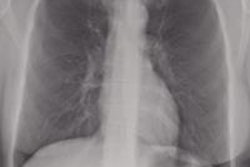At the cost of more false positives, the combination of computer-aided detection (CAD) and electronic bone suppression can help radiologists improve detection rates for pulmonary nodules on chest radiographs, according to research published in the May issue of the American Journal of Roentgenology.
In a retrospective study involving 101 patients and three radiologists, a team of European researchers led by Dr. Zsolt Szücs-Farkas of the University of Bern in Switzerland found that CAD -- either alone or in combination with bone suppression software -- offered significant gains in sensitivity over conventional chest radiographs alone.
While a number of studies have explored the utility of bone suppression or CAD techniques for chest radiography, the feasibility of software-only bone suppression on conventional radiography in combination with CAD hadn't been tested, according to the authors. As a result, the team sought to compare the effect of dual-energy subtraction techniques with bone suppression software on human observers for detecting lung nodules (AJR, May 2013, Vol. 200:5, pp. 1006-1013).
The researchers retrospectively selected 101 patients with one to five nodules measuring 5-29 mm and 42 subjects with no nodules. The cases were randomized and were read by three independent radiologists, who marked suspicious-appearing lesions on the original chest radiographs, dual-energy subtraction images, and bone-suppressed images before and after CAD postprocessing.
The readers included a board-certified radiologist with 11 years of experience in chest image interpretation and two radiology residents with 1.5 years and three years of experience, respectively, with dual-energy subtraction. All images were read in two sessions separated by an interval of 14 to 28 days.
Each original chest radiograph was postprocessed by version 2.0 of the ClearRead bone suppression software (Riverain Technologies). In a second step, version 5.1 of the OnGuard CAD software was applied to all original posteroanterior chest radiographs and soft-tissue images from dual-energy subtraction, as well as those generated from the bone suppression software.
The team then compared the observer and CAD marks with the reference standard of CT studies. The combination of bone suppression software and CAD yielded the highest reader sensitivity, while conventional chest radiography performed the worst, as indicated in the table below.
| Performance of x-ray processing techniques | ||
| Technique | True-positive nodules | Sensitivity |
| Bone suppression with CAD | 80 | 51.6% |
| Chest x-ray with CAD before bone suppression | 79.33 | 51.2% |
| Chest x-ray and CAD | 78 | 50.3% |
| Bone suppression software | 77 | 49.7% |
| Dual-energy subtraction | 76.33 | 49.2% |
| Dual-energy subtraction and CAD | 75.33 | 48.6% |
| Chest x-ray before application of dual-energy subtraction | 72.67 | 46.9% |
While dual-energy subtraction alone (p = 0.0198) and CAD alone (p = 0.0095) significantly improved nodule detection in comparison with the original chest radiograph, the use of bone suppression software alone did not yield a statistically significant increase (p = 0.1075). It did, though, when paired with CAD (p = 0.0055).
"The results of our study show that bone subtraction by dual-energy subtraction and CAD alone or in combination with electronic bone suppression by [bone suppression imaging] are capable of improving the detection rate of pulmonary nodules on conventional chest radiography," the authors wrote. "However, the increased rate of detected nodules corresponds with a higher number of false-positive lesions."
| Mean number of nodules identified by observers & CAD | ||||
| Both readers & CAD | Readers correctly identified but CAD missed | Readers missed but CAD identified | Missed by both readers & CAD | |
| Chest radiograph | 49 | 29 | 18 | 59 |
| Dual-energy subtraction | 55.67 | 19.67 | 22.33 | 57.33 |
| Chest radiograph before bone suppression software | 51.33 | 28 | 17.67 | 58 |
| With bone suppression software | 51.67 | 28.33 | 17.33 | 57.67 |
"Up to 22.9% of lesions were found only by the CAD program and were missed by the readers," the authors wrote.
While readers marked slightly more true-positive findings using bone suppression than dual-energy subtraction, that difference did not reach statistical significance (p = 0.8451).
In other findings, dual-energy subtraction and bone suppression provided the same false- and true-positive rates.
Electronic bone suppression offered similar detection rates for pulmonary nodules, albeit with better image quality, compared with classic dual-energy subtraction techniques, the authors concluded. In addition, CAD, alone or together with bone suppression, can significantly improve reader sensitivity for lung nodules, according to the team.
"Even if projection radiography will never compete with the sensitivity of CT, we think that the software-only bone suppression technique might be a cost-effective alternative for dual-energy subtraction chest radiography in the detection of lung nodules," the authors wrote.




















